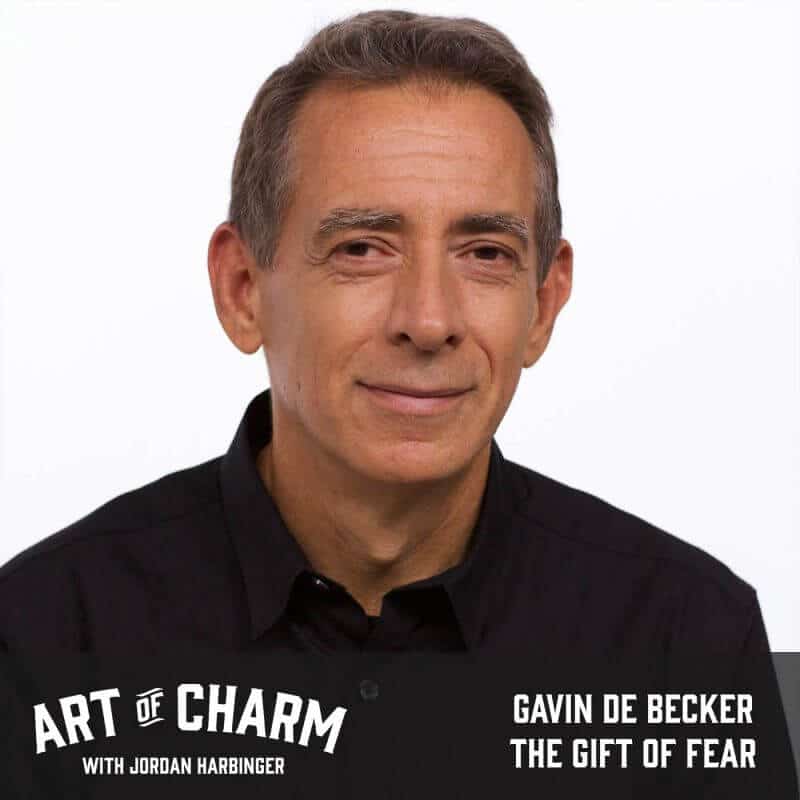Gavin de Becker is the the author of The Gift of Fear and Other Survival Signals That Protect Us from Violence and the security pioneer who designed the MOSAIC Threat Assessment Systems used at the top levels of government. This is the first part of a two-part series (check out part two here).
The Cheat Sheet:
- Violence is a reality — if you’re not prepared for its possibility, you’ll be caught off guard by its eventuality.
- Learn how to hone your sixth sense for danger.
- Discover how to spot the red flags that signify someone as a likely abuser, con artist, or predator.
- How can technology paired with human intuition protect us from people who mean us harm?
- How literal is the term “gut feeling?”
- And so much more…
[aoc-subscribe]
Download Episode Worksheet Here
Violence is built into the human mind. Try to imagine the most grisly way of being violated by another human being; since you’re able to contemplate it in the first place, it’s likely been done to someone — or maybe even many people — in the past. It’s part of human nature.
The Gift of Fear and Other Survival Signals That Protect Us from Violence author and MOSAIC Threat Assessment Systems developer Gavin de Becker joins the show to discuss his decades of experience in protecting people from the top levels of government to victims of spousal abuse. Think of this as sort of an AoC toolbox episode in two parts (check out part two here) for safety — for men and women. Learn and enjoy!
More About This Show
Violence is a reality. And like any other unpleasant reality, it’s better to be prepared for its possibility than caught off guard by its eventuality. Gavin de Becker, author of The Gift of Fear and Other Survival Signals That Protect Us from Violence and the security pioneer who designed the MOSAIC Threat Assessment Systems that’s been relied upon by the top levels of government since the early ’80s, understands better than most what it takes to second guess the unthinkable.
Pairing old-fashioned human intuition with technology isn’t a straightforward science, and accurate prediction of any outcome that involves decisions by human beings is never foolproof. But a system that takes the nuances of human behavior into account is going to be right more often than one that only evaluates a binary presence or non-presence of certain factors.
“There’s a MOSAIC system for assessing which spousal abusers will escalate to homicide,” says Gavin. “And there’s one for assessing which school threateners will actually carry out threats. So if you ask a question like, ‘Does the person have a gun?’ old strategies had people saying ‘Yes/No’ — kind of a…checklist. It’s either present or it’s not present. But our MOSAIC system provides a range of optional answers, because there is a range in human behavior.”
As an example, Gavin points out that trying to evaluate the likelihood of a gun owner committing violence should include specific considerations about the gun owner that pre-MOSAIC tests would ignore. MOSAIC would differentiate between someone who owns a gun for defensive purposes in their house from somebody who just bought a gun yesterday and from somebody who has thirty guns.
“[MOSAIC is] artificial intuition,” says Gavin. “It’s a method that brings the evaluator’s intuition to the table and organizes it in a way that can be replicated over and over again. When you do that with a thousand cases, you begin to see patterns of human behavior…predictions of violent behavior are not substantively different from predictions of any other kind of behavior. You need a base of knowledge about the ways that people behave, and what factors are in their life. I gave you the example of a gun. Just owning a gun — when you recognize that hundreds of millions of people do — that’s not enough to put you over or under with regard to a safety evaluation. There are so many other factors that are more unique.”
Listen to this episode of The Art of Charm in its entirety to learn more about common patterns of human behavior that predict counterintuitive outcomes, why we shouldn’t be so quick to trust our dog’s instincts over our own when it comes to judging strangers (but what we can learn from a perspective that’s free of cognitive bias), how to weigh intuition versus denial, why Gavin recommends striking the word should from our vocabulary, how having a gut feeling is more accurate than you might realize, how advice from Gavin probably saved a younger and more naive Jordan’s life, what we can do to hone our intrinsic intuition, and lots more.
THANKS, GAVIN DE BECKER!
Resources from This Episode:
- Episode 579: The Gift of Fear Pt. 2
- The Gift of Fear and Other Survival Signals That Protect Us from Violence by Gavin de Becker
- Other books by Gavin de Becker
- Gavin de Becker & Associates
- MOSAIC Threat Assessment Systems
You’ll Also Like:
- The Art of Charm Challenge (click here or text 38470 in the US)
- The Art of Charm Bootcamps
- Best of The Art of Charm Podcast
- The Art of Charm Toolbox
- The Art of Charm Toolbox for Women
- Find out more about the team who makes The Art of Charm podcast here!
On your phone? Click here to write us a well-deserved iTunes review and help us outrank the riffraff!




